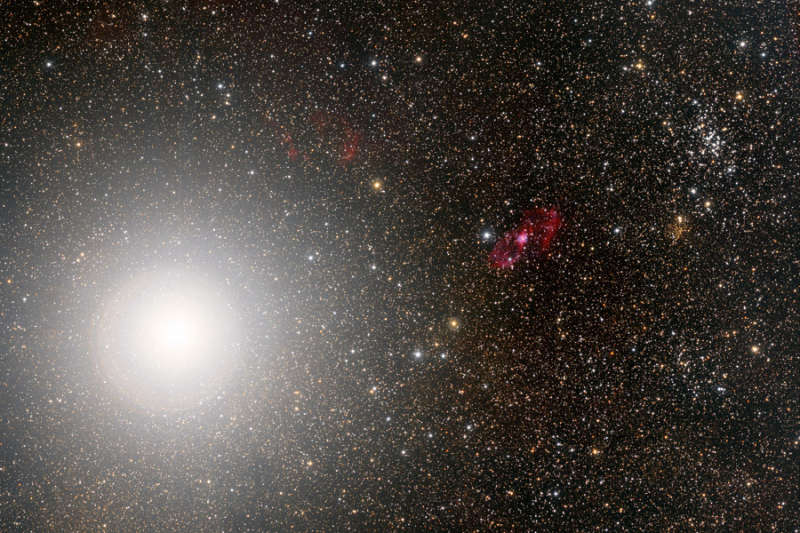Credit & Copyright: Marco Lorenzi
(Glittering Lights)
Explanation:
The glare of Alpha Centauri, one of the brightest stars in planet
Earth's night sky, floods the left side of this
southern skyscape.
A mere 4.3 light-years distant,
Alpha Centauri actually consists of two
component stars similar in size to the Sun, locked in a mutual orbit.
Much smaller and cooler, a third member of the same star system, Proxima
Centauri, lies outside this field of view.
Still, the telescopic scene does reveal often overlooked denizens of the
Milky Way's crowded galactic plane that lie beyond the glare of Alpha
Centauri, including a planetary nebula
cataloged as Hen 2-111, an estimated 7,800 light-years away.
The gaseous shroud of a dying star,
the nebula's brighter core and
fainter halo of reddish ionized gas span over twenty light-years, seen
just right of picture center.
Farther right are two notable
open clusters
of stars, the
compact
Pismis 19 also nearly 8,000 light-years
away whose light
is reddened by intervening dust, and the looser, closer NGC 5617.
Just visible in the glare of Alpha Centauri is the dim glow of a shell-like
supernova remnant,
above and right of the closest star system's bright core.
1999 2000 2001 2002 2003 2004 2005 2006 2007 2008 2009 2010 2011 2012 2013 2014 2015 2016 2017 2018 2019 2020 2021 2022 2023 2024 2025 |
Yanvar' Fevral' Mart Aprel' Mai Iyun' Iyul' Avgust Sentyabr' Oktyabr' Noyabr' Dekabr' |
NASA Web Site Statements, Warnings, and Disclaimers
NASA Official: Jay Norris. Specific rights apply.
A service of: LHEA at NASA / GSFC
& Michigan Tech. U.
|
Publikacii s klyuchevymi slovami:
planetary nebula - supernova remnant - Al'fa Centavra - Mlechnyi Put' - zvezdy
Publikacii so slovami: planetary nebula - supernova remnant - Al'fa Centavra - Mlechnyi Put' - zvezdy | |
Sm. takzhe:
Vse publikacii na tu zhe temu >> | |
